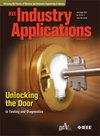一种超快负载瞬态响应双电容电流斜坡积分恒导通(dcrcrot)控制降压变换器
IF 4.5
2区 工程技术
Q2 ENGINEERING, ELECTRICAL & ELECTRONIC
引用次数: 0
摘要
随着人工智能(AI)在移动设备中的快速发展,对处理器的快速瞬态响应和高轻载效率等电源要求越来越重要。本文提出了一种双电容电流斜坡积分恒导通(dccrot)控制方法,以实现超快的负载瞬态响应和比其他控制方案更高的抗噪性。传统的电容电流传感控制方案可以保证超快的负载瞬态响应,但存在传感电路失配引起的不稳定性。因此,提出了一种双电容电流斜坡积分方案,在不牺牲负载暂态响应的情况下提供稳定的运行。此外,该方案提高了噪声抗扰性,在连续导通模式(CCM)和断续导通模式(DCM)下都提供了精确的触发。该芯片采用0.18 μm CMOS工艺,尺寸为1289 μm × 1199 μm。实验结果表明,在1.1 a升压和1.1 a /70 ns压转率条件下,负载瞬态响应速度快,输出压降接近最优值为62 mV(与理想值的偏差仅为1.9%),响应时间为1.6 μs,无不稳定性问题。本文章由计算机程序翻译,如有差异,请以英文原文为准。
An Ultrafast Load Transient Response Double Capacitor Current Ramp Integrating Constant on-Time (DCCRICOT) Controlled Buck Converter
With the rapid advancement of artificial intelligence (AI) in mobile devices, power supply requirements such as fast transient response and high light-load efficiency for processors are increasingly critical. In this article, a double capacitor current ramp integrating constant on-time (DCCRICOT) control is proposed to achieve an ultrafast load transient response and a high noise immunity over other control schemes. Conventional control schemes with capacitor current sensing ensure an ultra-fast load transient response but suffer from sensing circuit mismatch-induced instability. Hence, a double capacitor current ramp integrating scheme is proposed to provide stable operation without sacrificing load transient response. Moreover, this scheme improves noise immunity, providing accurate triggers in both continuous-conduction mode (CCM) and discontinuous-conduction mode (DCM). Implemented in a 0.18 μm CMOS process, this chip size is 1289 μm by 1199 μm. Experimental results demonstrate a fast load transient response with a 62 mV near optimal output voltage drop (deviation-from-ideal rate is only 1.9%) and a 1.6 μs response time without any instability issue under conditions of a 1.1 A load step-up with a 1.1 A/70 ns slew rate.
求助全文
通过发布文献求助,成功后即可免费获取论文全文。
去求助
来源期刊

IEEE Transactions on Industry Applications
工程技术-工程:电子与电气
CiteScore
9.90
自引率
9.10%
发文量
747
审稿时长
3.3 months
期刊介绍:
The scope of the IEEE Transactions on Industry Applications includes all scope items of the IEEE Industry Applications Society, that is, the advancement of the theory and practice of electrical and electronic engineering in the development, design, manufacture, and application of electrical systems, apparatus, devices, and controls to the processes and equipment of industry and commerce; the promotion of safe, reliable, and economic installations; industry leadership in energy conservation and environmental, health, and safety issues; the creation of voluntary engineering standards and recommended practices; and the professional development of its membership.
 求助内容:
求助内容: 应助结果提醒方式:
应助结果提醒方式:


